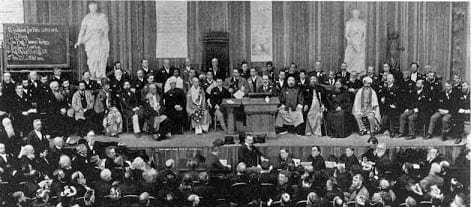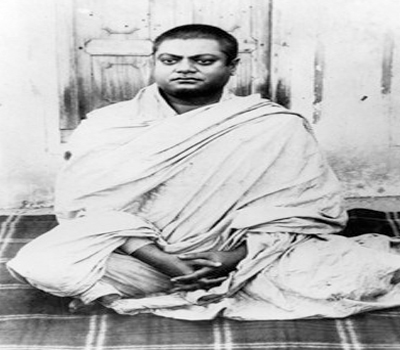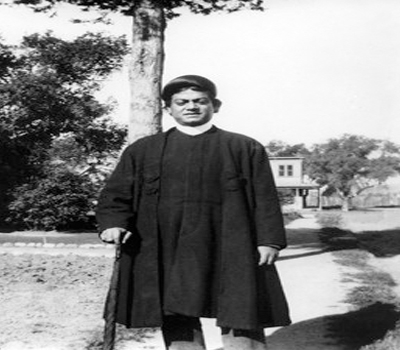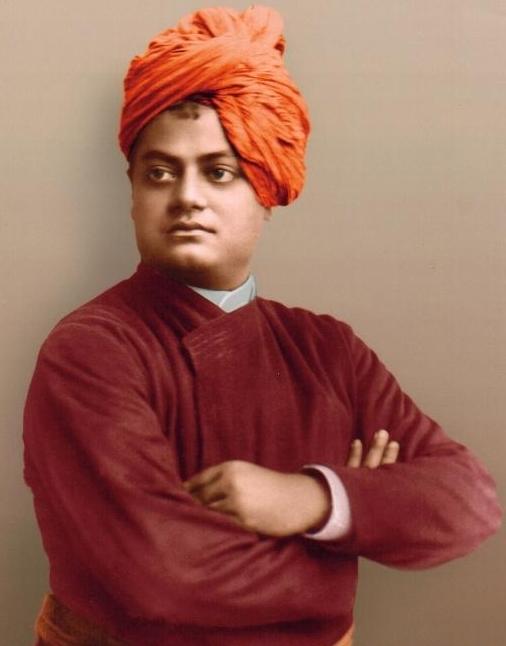ABOUT A YEAR AGO some of us were riding in a car in New York State with the radio on when we heard the announcer say, in a Southern drawl: ‘There’s a beautiful weekend coming up, folks—a good time to go out and be one with nature.’ It suddenly struck one of us: Would the phrase ‘be one with nature’—or, one with anything else, for that matter—be popular if it had not been for Swami Vivekananda? We take that phrase so much for granted now,but what if Swamiji had never come to the US? Would anyone in the US be speaking or thinking in those terms? What the announcer himself meant by the phrase is anybody’s guess, but the fact that it was said on public radio is telling.
Most of us live in a city, and we are used to a lot of background noise that gets partially tuned out—traffic noises, horns blowing, people talking, electrical equipment running, and so on. So when one visits a secluded place, the first thing one notices is the quiet. Even with birds chirping and other animals making noises, it still seems so calm and quiet.
Some yogis and realized souls might be able to hear the sound of Om in such a place. Or others might even be able to see the divine Consciousness behind everything—the ultimate Reality underlying this ‘framework of illusion’, as Sri Ramakrishna called it. But such people are extremely rare. Other people may simply try to imagine that divine Consciousness present in everything.
Still others would be happy to just be able to feel oneness with a life principle that seems to pulsate all around them. Perhaps they feel that the whole forest—the trees and plants, birds and animals, even rocks and stones—and they themselves are vibrating with life, with that life principle. This is, perhaps, what many people mean by ‘being one with nature’. But for most people, the term has just become a popular phrase, and they hardly stop to think about what it really means. Most people are happy to simply see the sights, hear the sounds, and breathe in the smells of the woods.
Never mind that this is not exactly what Swamiji meant in his lectures in the West when he talked about ‘the unity of all existence’ or ‘the whole universe is one existence.’1 ‘Being one with nature’ is a good start.
Here we might ask: Did this really come from Swamiji? Is it really possible that Swamiji’s ideas could spread in such a far-reaching way? We must remember that Swamiji attracted some brilliant minds to his lectures and classes—particularly to his classes in New York City. These attendees were not ordinary people. Many of his students were already—or later became—spiritual teachers in their own right. Later, in order to attract students, they would often advertise as one of their credentials that they were a student of Swami Vivekananda. All of these teachers then, in turn, spread Swamiji’s ideas to a greater or lesser degree.
There is one woman in particular we can mention here: Mrs May Banks-Stacey, Matre, Rosae Crucis America. In January 1916, The American Rosae Crucis journal introduced in their very first issue Mrs Banks-Stacey as the first head of their society in the US, saying, ‘She is one of the founders of Rosae Crucis in the United States and the Matre of the Grand Lodge of America.’ While giving her credentials, it is mentioned: ‘She has studied the mysteries of Hindoo philosophy under Swami Vivekananda, Abekananda [sic] and Baha Ullah, and also has been a member of the Theosophists Inner Circle.’2 A person like her would have influenced many thousands of people.
Swami Abhedananda and other later monks who taught in the US also attracted leading writers and intellectuals to their classes—people like Joseph Campbell, Aldous Huxley, Huston Smith, and Pitirim Sorokin, to name just a few. Again, these people, in turn, have influenced millions of people through their talks and writings. Thus many people have been instruments in the spread of Swamiji’s message.3
Regarding what Swamiji taught and the impact of those ideas on society today, we shall look at a powerful lecture that he gave on 8 April 1900 in San Francisco entitled, ‘Is Vedanta the Future Religion?’ Here he gave what he felt were his final ideas about the Vedanta work in America. His ideas must have sounded quite revolutionary at the time to a Western audience, yet it was among the Westerners—and particularly those of the US—that he felt he had a good chance of working out these ideas. So it is good to look back on this talk 113 years later and take another look at what this ‘future religion’ was that Swamiji had in mind. We can also see what is happening with those ideas now—at least in the popular culture of the West.
By Vedanta Swamiji was referring specifically to non-dualistic Vedanta. In this lecture Swamiji worked through—for a sometimes sceptical audience—all the possible implications of the doctrine of non-dualism. Consider the following, for instance. Swamiji said: ‘It is one body, one mind, one soul throughout. Spirit never dies. There is no death anywhere, not even for the body. Not even the mind dies. How can the body die? One leaf may fall—does the tree die? The universe is my body. See how it continues. All minds are mine. With all feet I walk. Through all mouths I speak. In everybody I reside.’4
Is there no death for the body? Obviously, Swamiji is speaking here from the universal standpoint, not from the standpoint of individual bodies—that is, from the standpoint of one universal Self. Swamiji was a master at jolting people out of their complacency and their ordinary materialistic view of life with statements like this.
To make it more clear, Swamiji said: ‘Immortality is knowing ourselves as one with all, living in all bodies, perceiving through all minds. We are bound to feel in other bodies than this one. … What is sympathy? Is there any limit to this sympathy, this feeling in our bodies? It is quite possible that the time will come when I shall feel through the whole universe’ (8.130).
Here again, on this point, the popular culture in the West seems to be waking up to Swamiji. Just as the phrase ‘being one with nature’ has become popular, similarly the phrase ‘we are all one’ has become a mantra for this age. In a recent well-known comic strip, a rather sardonic rat is coaching a little girls’ basketball team. He is giving them a pep talk to inspire them to trounce the other team when a little girl starts talking about how ‘all humanity is one—you know, one energy, one love’. She goes on to say that by their winning the basketball game they will make the other team sad, and the sadness a person causes to others really makes oneself sad. The rat is confused and cannot understand at all where this conversation is going, so all the other little girls then chime in to make it clear: ‘Forfeit [the game]!’ In the last panel of the cartoon a referee blows his whistle and declares the game a ‘metaphysical forfeit’.5
With or without the comic strips, this aspect of oneness is also taking hold. This aspect takes oneness to another level—to a true identification with other people, and not just with some nebulous ‘nature’. The stakes are raised here, as identifying oneself with other people requires more of a personal commitment. It is amazing to see how this is taking place in the US now. People’s awareness has been raised. More and more they are realizing that what happens to other people in another part of the country—or even in another part of the world—affects everyone.
We often assume that Swamiji emphasized the worship of God in human beings only in India. But we find that in this lecture Swamiji included this aspect also in his idea of the religion of the future for the US. As Swamiji said: ‘Worship everything as God—every form is His temple. All else is delusion.’6 And again: ‘Just now I am worshipping you. This is the greatest prayer. Worship the whole world in that sense—by serving it. This standing on a high platform [lecturing], I know, does not appear like worship. But if it is service, it is worship’ (8.135).
Swamiji would be happy to see how many religious organizations in the US—including many Protestant churches—have taken up social welfare work. Except among Catholic monastics, this was almost unheard of fifty or sixty years ago. Now almost all religious groups in the US—Protestant and Catholic—take up some kind of work for the poor, such as organizing soup kitchens to feed the homeless; repairing the homes of the poor after devastating hurricanes and tornadoes; setting up day-care facilities for children of poor working mothers; or doing after-school tutoring for poor children. All these things are done mostly by volunteers from the religious organizations themselves, and not by paid staff. These volunteers use their time off from their jobs, or even their vacation days, to do this service.
It is true, the philosophy of worship of God in human beings is not explicitly expressed when most of these people perform this type of work, yet those who do this work through their religious organization do it out of love of God, and they do it selflessly. This too is karma yoga.
Another point Swamiji brought up in this lecture is a rather controversial point, and it is, in fact, a topic that is being hotly debated now in the US. In the West it is referred to as ‘being spiritual but not religious’. What Swamiji really meant in his lecture, only he knows; but what he said is this: ‘If you take my advice, you will never enter any church. Come out and go wash off. Wash yourself again and again until you are cleansed of all the superstitions that have clung to you through the ages’ (8.134).
Here, by the word ‘superstitions’, Swamiji was referring to the idea of worshipping a God outside of oneself. Immediately before this, Swamiji said: ‘What is the God of Vedanta? He is principle, not person. You and I are all personal Gods. The absolute God of the universe, the creator, preserver, and destroyer of the universe, is impersonal principle. … You want to worship personal Gods. It is the worship of your own self ’ (8.133–4).
Nowadays many people in the US are not affiliating themselves with a church, synagogue, mosque, or temple, or with any particular religion or sect. And many of them declare themselves to be ‘spiritual but not religious’. Their main reason for remaining unaffiliated is that they do not want to declare their belief in any doctrines or dogmas that they cannot wholeheartedly accept.7 This is what they mean by ‘superstitions’. This is okay; Swamiji would accept this. However, for the most part these people have neglected Swamiji’s original idea, his main point—that is, realizing one’s own Divinity. Unfortunately, when the debates on this issue come up, that part of the equation—the divinity of one’s own Self—is not mentioned. The debates only have to do with whether or not a person can find God outside a religious organization.
The divinity of one’s own Self was primary whenever Swamiji talked about non-dualism. As he said: ‘But God is the infinite, impersonal being, ever existent, unchanging, immortal, fearless; and you are all His incarnations, His embodiments. This is the God of Vedanta, and His heaven is everywhere. In this heaven dwell all the personal Gods there are—you yourselves. Exit praying and laying flowers in the temples!’8
This is the aspect of ‘oneness’ that has not yet dared to raise its hood in America—not yet, at any rate. Perhaps the time is not ripe for it now.
Swamiji, however, was hopeful. His final message in this lecture was:
For thousands of years millions and millions all over the world have been taught to worship the Lord of the world, the Incarnations, the saviours, the prophets. They have been taught to consider themselves helpless, miserable creatures and to depend upon the mercy of some person or persons for salvation. There are no doubt many marvellous things in such beliefs. But even at their best, they are but kindergartens of religion, and they have helped but little. Men are still hypnotized into abject degradation. However, there are some strong souls who get over that illusion. The hour comes when great men shall arise and cast off these kindergartens of religion and shall make vivid and powerful the true religion, the worship of the spirit by the spirit’ (8.141).
This lecture was one of Swamiji’s last in the US, and this was Swamiji’s conclusion in this lecture: ‘ Devo bhutva devam yajet; one worships the Divine by becoming the Divine. Even if the time is not yet ripe for this aspect of Swamiji’s message, we can understand that if other ideas have begun to sprout, this aspect too will come forth from the seeds that Swamiji sowed 113 years ago. As he said: ‘You may not like what I am saying. You may curse me today, but tomorrow you will bless me’ (8.135). ‘The hour comes,’ said Swamiji, so it will come.
Notes and References
1. The Complete Works of Swami Vivekananda, 9 vols (Calcutta: Advaita Ashrama, 1–8, 1989; 9, 1997), 8.139
2. The American Rosae Crucis: A Magazine of Life’s Mysteries, 1/1 ( January 1916), 17.
3. Interested readers can go through a wonderfully researched article of how Swamiji’s influence spread by Pravrajika Vrajaprana, ‘ World Thinkers on Ramakrishna Movement’, in The Story of Ramakrishna Mission (Kolkata: Advaita
Ashrama, 2006), 1097–143.
4. Complete Works, 8.129.
5. See ‘Pearls Before Swine’, 22 September 2013; <www.news.yahoo.com/comics> accessed 13 November 2013.
6. Complete Works, 8.136.
7. These days because of a decrease in attendance in Christian churches, many churches are dropping their requirements for belief in certain doctrines. For instance, fifty years ago people could not take communion in a particular church unless they had become members of that particular sect of that denomination of the church by formally professing their faith in the doctrines of that sect. Many churches no longer have this requirement. Anyone who wants to take communion can do so without making any doctrinal commitments. Again, a Christian minister recently told one of our nuns that young people will not come to his church if the church claims that ‘Jesus is the only way’ to salvation. Young people insist that the church must accept other paths and say that ‘Jesus is one of the ways’. Churches, out of necessity, are having to become more liberal to suit the times.
8. Complete Works, 8.134.







Leave A Comment